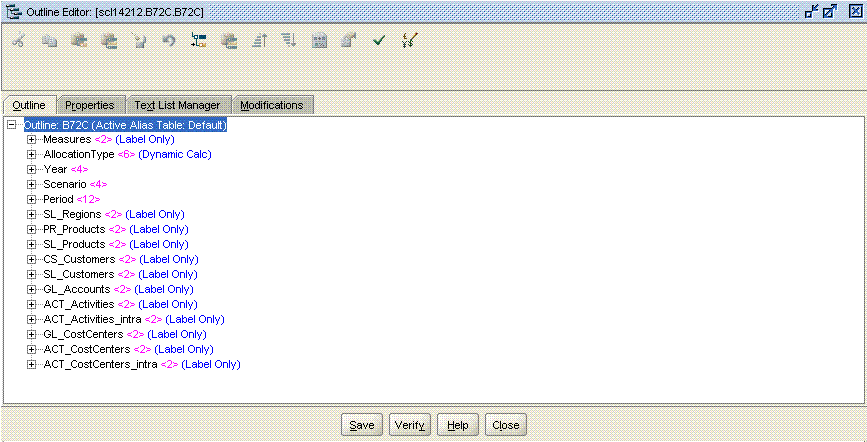About Profitability and Cost Management Dimensions
Oracle Hyperion Profitability and Cost Management uses dimensions and members created in the Profitability Applications Console to represent many of the structural elements of the business model in an Oracle Essbase application outline.
The following are dimensions used by all types of Profitability and Cost Management applications:
-
Business dimensions that reflect the business-specific elements of the model, such as departments, accounts, activities, customers, or products; they may apply to one or more stages or models.
-
POV dimensions that identify a specific point of view or version of the model, such as year, scenario, period, and version; version dimensions enable you to maintain multiple versions of a model and can be used to create alternate, or what-if, scenarios of the model, or different perspectives
-
Attribute dimensions that enable analysis based on the attributes or qualities of dimension members. Attributes describe characteristics of data, such as the size or color of products
-
Alias dimensions (optional), used to assign alternate names, descriptions, languages, or other items that help to define dimensions
Note:
The Management Ledger Rule and Balance dimensions are system dimensions that are seeded and should not be edited in any way, even if some part of the system allows it (for example, Update Dimensions in the Profitability Applications console). These dimensions are reserved for system use.The database outline provides the data structure for the model, and includes calculation instructions and formulas. Dimensions in the Essbase outline are hierarchical. Data is stored at dimension intersections. Each stage in a detailed profitability model may include up to three dimensions.
Caution:
Members must not be repeated within the same dimension; however, a member can be repeated across several dimensions.
The following image shows a sample Essbase outline of a standard profitability calculation database, shown on the Essbase console.
Figure A-2 Standard Profitability Dimension Outline in Essbase

Although there is no physical limit to the number of dimensions and members that can be created, performance issues can occur with large dimensional structures.
The dimensions are created and maintained in the Profitability Applications Console, and must exist before they can be used in models. Through the Profitability Applications Console, the Profitability and Cost Management Administrator can select existing dimensions and members from other products, or create new dimensions and members specifically for the model. The common data can be shared and updated between multiple products and applications. The dimensions and their members are available in Profitability and Cost Management applications after the applications are deployed.
Caution:
Oracle recommends that you do not add or delete dimensions and dimension hierarchies after the modeling process has begun.
For each dimension, a dimension type and dimension name must be specified:
-
The dimension type is a dimension property that enables the use of predefined functionality in the application. For Profitability and Cost Management dimension types, see Dimension Types.
-
The dimension name identifies the contents of the dimension, in relation to the organization or business. For example, a dimension of Account type may be given a dimension name, such as General Ledger or Chart of Accounts. The dimension name does not need to reflect the dimension type, although it may.
Note:
It is advised to not use any of the system dimension member names for member names in any of the other dimensions or hierarchies. For example, DirectAllocation or GenealogyAllocation are system members in the AllocationType dimension and these names should not be used in any other dimensions in the model. This is good practice for all Profitability and Cost Management application types.
Oracle strongly recommends avoiding the use of special characters within dimension member names. The '_'; (underscore) and ' '; (space) characters are supported in member names. Other special characters may not work in all cases and their use is discouraged.
To enter or load a data value to an Essbase database, you assign the data value a member from every dimension in the database. This is referred to as the dimension intersection for the data value. A dimension intersection identifies a unique database location or cell.
For naming conventions for dimensions and members, see the Oracle Hyperion Profitability and Cost Management Administrator's Guide.